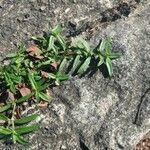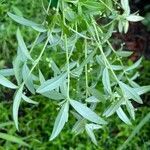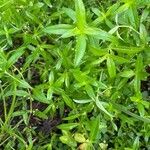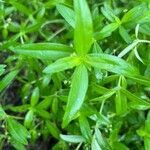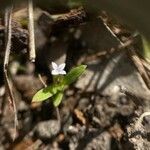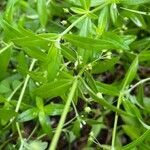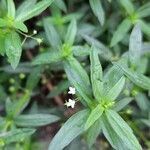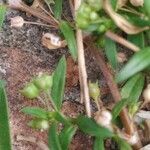Herbs, prostrate or erect, to 1/3 m tall, sparsely to much branched, the branch-es lax, glabrous, shiny. Leaves narrowly oblong or linear, 1.5-2.0(-3.0) cm long, to 0.45 cm wide, deltoid to acute at the apex, cuneate at the base, the costa evanescent above or barely visible, scarcely prominulous beneath, the lateral veins evanescent, the margin scabridulous, with some proximal papillae, thinly carnose, concolorous, glabrate beneath; petioles to 1 mm long, inserted in the sheath of the connate stipules; stipules cupuliform or obconical, to 2.5 mm long, the cup with several ascending or deflexed glandular fimbriae of unequal length, often exceeding the sheath in length. Inflorescences mostly at the nodes, the flowers solitary or often 2 or 3, infrequently disposed in corymbs of 4-5 flowers, the peduncles filiform, usually about 1/2 as long as the leaves, the pedicels filiform, shorter or longer than the peduncle. Flowers isostylous with the hypanthium small, the calycine lobes 4, triangular, to 1.1 mm long, scabrid marginate; corolla lavender or white, the tube ca. 0.6 mm long, the lobes 1-2 mm long; stamens 4,
An erect annual herb. It grows 30 cm high. The leaf blades are 1-4 cm long by 1-7 mm wide. The leaves are entire, sword shaped and opposite. The flowers are white. They are in long stalked groups. The flowers occur as 1 to several in the axils of leaves. The fruit is a half round capsule 1-2 mm long by 2-3 mm wide. The seeds are pale brown. They are 0.3 mm long. There are some varieties.
Flowers not heterostylous, variously arranged, either 1-several single flowers in the axils or in 2–5(6)-flowered pedunculate umbel-like inflorescences, both kinds present on one branch or even at one node, the peduncles and pedicels mostly long and slender but rarely the flowers are fasciculate; peduncles (0)0.5–1.8(2.3) cm. long; pedicels (1.8)3–6(13) mm. long.
Leaf blades 0.6–3.5(5.3) cm. x 0.5–7 mm., linear to narrowly elliptic, acute and apiculate at the apex, narrowed to the base, glabrous to sparsely scabridulous above and on margins and also beneath, particularly on the main nerve; petioles not developed; stipule sheath 0.5–2(3) mm. long, produced at the middle with (2)3–5 unequal fimbriae, 0.5–1(2.5) mm. long.
the anthers sessile, rotund, inserted on upper 1/2 of the tube, the pistils glabrous. Fruits capsular, to 2.5 mm wide, truncate at the apex, subplane; seeds 1 per carpel, round, ca. 0.5 mm wide, areolate.
Annual herb, sparsely to very densely branched near the base; stems prostrate to ± erect, 1.5–30 cm. long, ridged, glabrous or scabridulous or pubescent on the ribs.
Corolla white or tinged blue, pink or purple or with 2 pink stripes on each lobe; tube 0.6–1 mm. long; lobes 0.5–1.2 mm. long, ovate to oblong.
Calyx tube 0.7–1 mm. long, ellipsoid; lobes 0.5–1.8 mm. long, triangular, setulose on the margins.
Seeds pale brown, c. 0.3 mm. long, ellipsoid or very obtusely depressed conic, reticulate.
An erect and diffusely branched herb, nearly glabrous, up to 1 ft. or more high
Capsule 1.2–2.2 x (1)1.8–2.8 mm., ovoid, the beak scarcely raised.
Style 0.5–1.5 mm. long.
Flowers white or mauve
